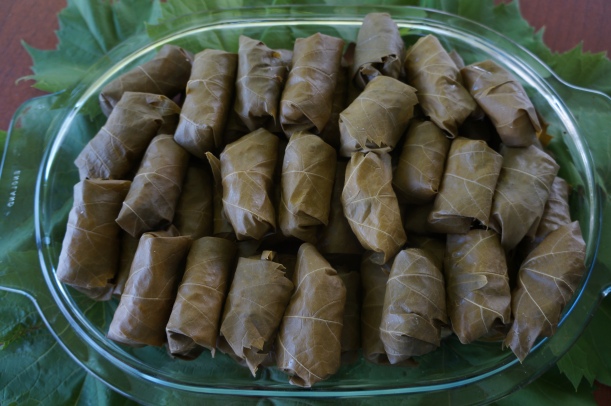
It’s that time of they year again when the grape leaves, be they wild or cultivated, are ready to be harvested. Last year I described the method for fermenting them and at the same time proposed stuffing them with something. I finally got around to doing it, and while it’s not a hard and fast recipe as such in that you can alter it to your taste, it is a very easy and delicious way to use the fermented leaves. Easier than dolmas to make as there is no stacking or prolonged cooking period, they are just as tasty and make a perfect appetizer or picnic dish.
Before I divulge my ‘recipe’, I must point out what I learned from fermenting the leaves. Not only are they arguably the easiest thing to ferment, they have many uses in salads, dips, sandwiches and whatever. What surprised me was that they lasted the entire year without any scary changes, the texture of the leaves and colour of the liquid did not suffer over the winter. I did not even refrigerate them – just stored them in a cool place in the basement. Knowing that, I feel it is worth fermenting an even larger batch this year, which means I need to have even more ways to use them.
For the stuffing, I used cooked sticky rice as a base. The only thing to note here is that your rice will be much better if you soak it in water for a couple of hours before cooking it. To the rice I added a little lemon juice, salt to taste, sauteed garlic and mushrooms (I used morels). Chopped roasted nuts, seeds, dried fruit or a combination of any of these would also work very well.

Roll the rice mixture in the leaves, vein side up, cover and refrigerate for up to one week in the fridge. I covered them with some loose fermented leaves which work as well as any plastic or aluminum wrap.

Linked to Angie@Fiesta Friday, Ai@Ai Made It For You and Jhuls@The Not So Creative Cook.
Related Posts: Wild Grape Leaves, Fermented Wild Grape Leaves, Grape Leaves with Roasted Vegetables, Pickerel in Grape Leaves with Mushroom Za’atar Sauce, Grape Leaf and Yogurt Pie and Quiche in Wild Grape Leaf Shells.







